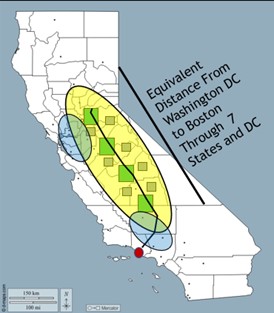California Inland Port
![]() Print this Article | Send to Colleague
Print this Article | Send to Colleague
For decades, the San Joaquin Valley has served as the principal goods movement corridor for North-South goods movement in California. Approximately 1.1 million ocean containers move through the San Joaquin Valley, about half that number representing imports (mostly consumer products) and the other half exports (mostly agricultural products). Currently, virtually all these goods are moved via highways with internal combustion engine powered trucks.
Catalyzed by conversations between the Port of Los Angeles, California Forward and Global Logistics Development Partners, this project was originally conceived in 2019 as a way to improve supply chain efficiency, reduce road congestion and improve air quality in the corridor from the Los Angeles area port complex and in the entire San Joaquin Valley. The project plan is to develop the most sophisticated dual-mode logistics and investment corridor in the world. Anchored by a series of large-scale TradePort hubs, the Inland Port would increase reliability and reduce cost for both inbound and outbound shippers. Depending on location, these TradePorts would provide access to new rail service transportation from port-to-inland hubs. The TradePorts would also be the location of new Truck Mobility Complexes, multimodal centers for supporting new clean powertrain truck fleets, for cargo exchange, demurrage, equipment management and for exchange between truck and rail modes.

The project offers multiple public benefits, and this is why the project has support from the State and a myriad of public agencies at the local, regional and federal level. The public benefits include:
1. Support for a more Efficient National Supply Chain System;
2. Creating substantial Reductions in GHG and Air Criteria Pollutants in California;
3. Significant Increase to Economic Competitiveness and Opportunity in the San Joaquin Valley;
4. Reductions in VMT, Road Congestion, and Maintenance Costs, and Increased Traffic Safety:
5. Improved Social Equity and Environmental impacts;
6. Improved availability of containers for Ag exports; and
7. Leverage of Public Sector Infrastructure Investment that Attracts Private Sector Investment
The initial feasibility assessment, (funded by the San Pedro Ports, the air districts in the San Joaquin Valley and South Coast, and San Joaquin Valley Councils of Government) showed significant cost advantages and large environmental benefits, including 93% reduction of GHG and 84% reduction of NOx.
Estimates are that a $200M dollar public sector infrastructure investment would generate $30B in private sector investment in the State with most of that centered in the San Joaquin Valley. Most of that investment will be in the form of clean energy, transportation/logistics and industrial asset development. The USDOT identified the project in 2021 as one of only five transformative Regional Infrastructure Accelerator projects in the nation. This designation provides the platform to structure a series of public-private investments.
The Fresno Council of Governments is acting as the public sector project coordinator on behalf of the eight regional Councils of Governments, the Ports of Los Angeles, Long Beach and Stockton, the South Coast, San Joaquin Valley and Sacramento Air Districts, as well as CalSTA, Caltrans, GoBiz, OPR and CDFA.
A special delivery entity is being created to coordinate implementation. The project will advance to the early stages of project delivery in 2023-2024 and with public funding of baseline infrastructure, the project will proceed on an expedited timeline.




